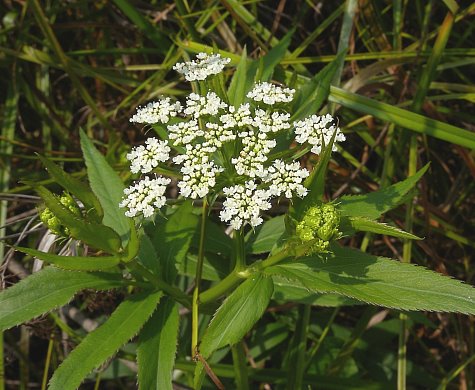
Regardless of which kind of leaves has been developed, this is followed by a flowering plant 2½-6' tall (above the ground or water surface) that branches sparingly. The stems of the flowering plant are light green, glabrous, and longitudinally veined; they are terete or angular-terete in cross-section. Alternate leaves along the stems are up to 1½' long and about one-half as much across; they are odd-pinnate with 7-17 leaflets. The leaflets of these compound leaves are 1½-4½" long and ¼-1¼" across; they are linear-lanceolate to narrowly lanceolate in shape and their margins are finely serrated. The upper surface of these leaflets is medium green and glabrous, while the lower surface is pale green and glabrous. The lateral leaflets are sessile, while the terminal leaflet of each compound leaf has a short petiolule (basal stalklet) up to 1" long. Each compound leaf has a sheath that extends along the entire length of its petiole (¼-4" long); the lower leaves have longer petioles than upper leaves. Both the petiole and rachis of each compound leaf is medium green, glabrous, and angular; they are often finely grooved along their upper surfaces.
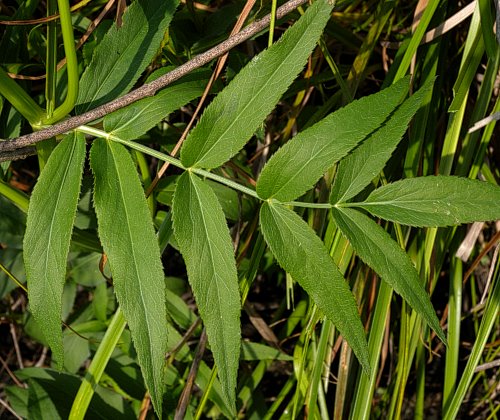
The upper stems terminate in compound umbels of flowers that span 2-5" across; these umbels are flat-topped and their peduncles are 1-5" long. Each compound umbel is divided into 8-22 umbellets, and each umbellet has 20-35 flowers. Each flower spans about 1/8 (3 mm.) across, consisting of 5 white petals with incurved tips, a short light green calyx with insignificant teeth, 5 exerted stamens, and a 2-celled ovary with a pair of divergent styles. The peduncles, rays, and pedicels of the compound umbels are light to medium green, glabrous, angular, and often finely grooved. The blooming period occurs from mid-summer to early fall, lasting about 1½ months. Each flower is replaced by an oblongoid-ellipsoid fruit about 1/8" (3 mm.) long that is slightly compressed and strongly ribbed; each fruit consists of a pair of seeds that are joined together. The root system consists of shallow fibrous roots that are slightly fleshy.
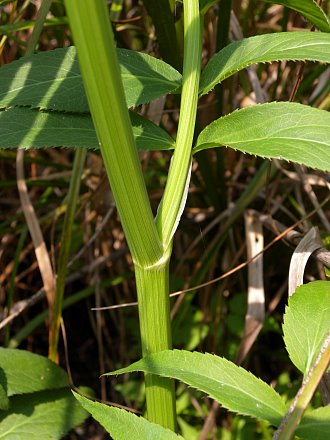
Cultivation: The preference is full or partial sun, shallow water (up to 1½' deep) or wet ground, and soil that is mucky or sandy. Depending on its level of exposure to standing water, Water Parsnip may produce terrestrial, semi-aquatic, or fully aquatic leaves during the early stages of its development.
Range & Habitat: The native Water Parsnip is occasional throughout Illinois (see Distribution Map). Habitats consist of soggy thickets, wet prairies, marshes, bottoms of seeps, low areas along springs, swamps, borders and shallow water of ponds, and ditches. This wildflower is found in both sandy and non-sandy wetland habitats.
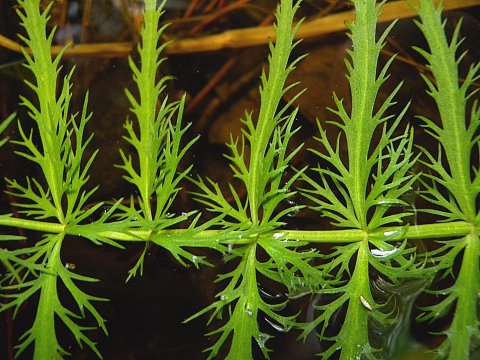
Faunal Associations: The flowers can attract a wide variety of insects, including Halictid bees, plasterer bees (Colletes spp.), masked bees (Hylaeus spp.), Sphecid wasps, spider wasps, cuckoo wasps (Chrysididae), Chalcid wasps, Eucoilid wasps, Ichneumon wasps, Braconid wasps, Vespid wasps, flower flies (Syrphidae), bee flies (Bombyliidae), Tachinid flies, flesh flies (Sarcophagidae), Muscid flies, Callophorid flies, frit flies (Chloropidae), leaf beetles (Chrysomelidae), ladybird beetles, and tumbling flowering beetles (Mordellidae). These insects obtain primarily nectar from the flowers (Robertson, 1929). Both adults and larvae of a leaf beetle, Prasocuris phellandrii, feed on the foliage of Water Parsnip. Unlike some wetland species in the Carrot family with white flowers, the foliage of Water Parsnip is not regarded as toxic to mammalian herbivores.
Photographic Location: Photos of the terrestrial plant were taken at a sandy marsh at the Heron Boardwalk in Vermilion County, Illinois. The photo of the semi-aquatic leaf was taken at the edge of a sandy swamp at the Irwin Prairie State Nature Preserve in NW Ohio.
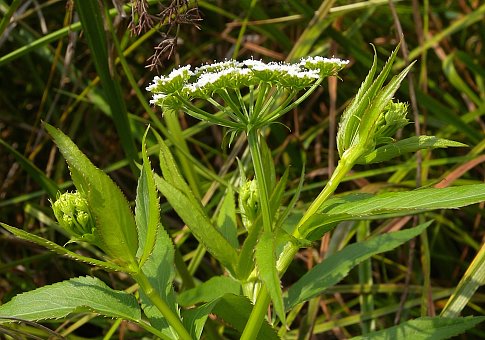
Comments: Water Parsnip is unusual in the variability of its leaves: they can be terrestrial, semi-aquatic, or aquatic. To make matters even more confusing to the novice, its terrestrial leaves can vary considerably in the width of their leaflets. It is also easy to confuse Water Parsnip with other white-flowered species in the Carrot family that prefer wetland habitats. Generally, these other species have fewer teeth along the sides of their leaflets and they produce neither aquatic or semi-aquatic leaves, even when they are found in standing water. Other key characteristics to consider while making an identification include whether the umbels of flowers are flat-topped or dome-shaped, whether the compound leaves are simple-pinnate or double-pinnate, and whether there are any floral bracts underneath the umbels or any floral bractlets underneath the umbellets.